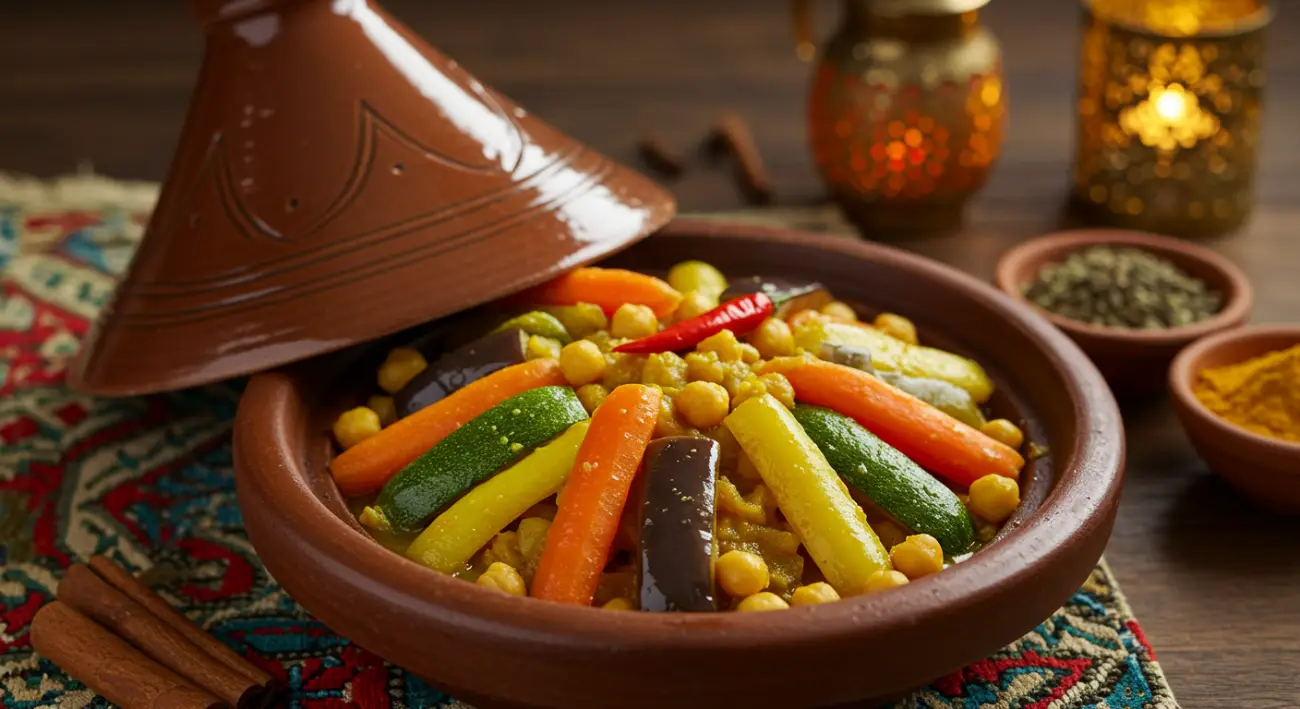Table of Contents
🫕 Introduction to Tagine Vegetable: A Moroccan Comfort Food
There’s something timeless and deeply comforting about a Moroccan vegetable tagine. Its aromas, textures, and traditions bring together not just ingredients, but people, stories, and culture.
When you think of comforting, flavorful dishes, tagine vegetable might not always come to mind first. Yet, in Morocco, it has been a beloved dish shared around family tables for centuries. More than just food, it’s a symbol of hospitality, patience, and gathering.
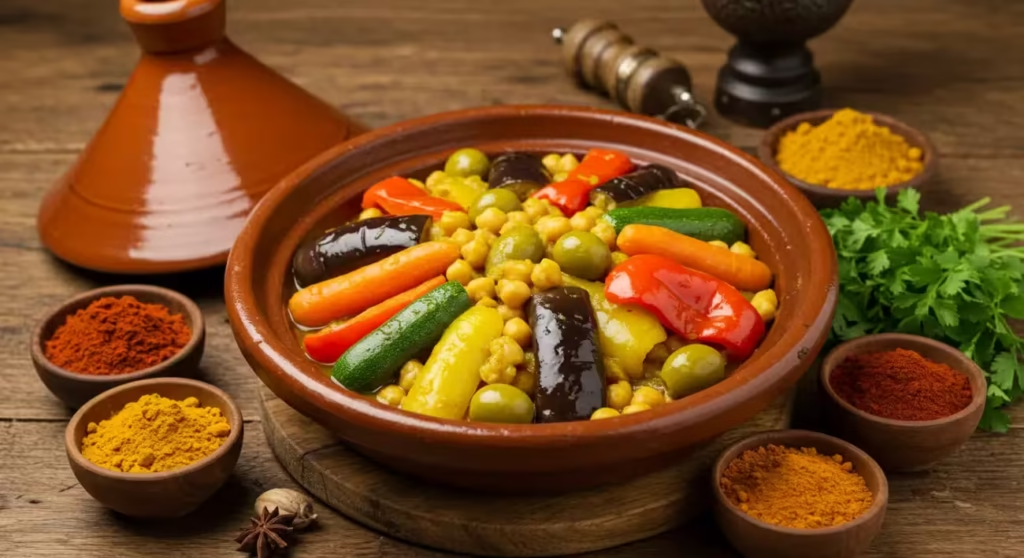
A tagine is not only a dish but also the iconic clay pot that gives Moroccan cuisine its signature slow-cooked flavors. Its conical lid creates a steam cycle, gently cooking vegetables and spices to perfection. The result is a rich, savory meal full of heart and tradition.
The magic of tagine vegetable lies in its ability to combine health, heartiness, and deep flavors. Bursting with fresh vegetables like carrots, zucchini, and bell peppers, it’s both nourishing and satisfying. Enhanced by Moroccan spices like cumin, turmeric, ginger, and cinnamon, every bite tells a story.
This versatile dish can easily adapt to different diets. Whether you are vegan, vegetarian, or enjoy adding chicken or lamb, the tagine vegetable fits perfectly. Traditionally served with fluffy couscous or warm Moroccan bread, it invites everyone to gather, share, and savor, just like the Moroccan chicken tagine with preserved lemons and olives, another classic of Moroccan cooking.
In this recipe, you’ll learn how to prepare an authentic Moroccan vegetable tagine and master the art of slow-cooking with traditional techniques, tips, and step-by-step instructions.You’ll discover why the tagine is considered one of the most iconic symbols of Moroccan culinary art.
For more regional inspiration and cultural context, you can also explore this guide to traditional Moroccan vegetarian dishes from The Spruce Eats.
🧄 Essential Ingredients for a Perfect Tagine Vegetable
What makes a tagine truly Moroccan isn’t just the pot, it’s the rich palette of ingredients passed down through generations. The vegetables, spices, and preserved elements each play a role in transforming this dish into a culinary tradition.
In Moroccan homes, a tagine is not just about the method of cooking but about the quality and combination of ingredients. Every family has its own twist, but the base always consists of fresh vegetables, aromatic spices, and staple North African ingredients that create comforting and memorable dishes.
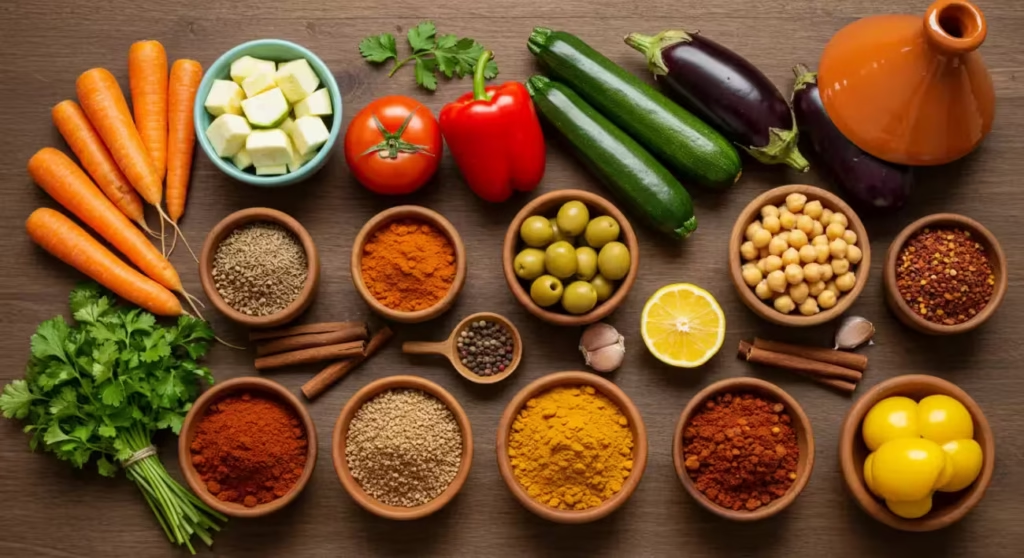
🥕 Common Vegetables Used in Tagine Vegetable
The heart of any vegetable tagine is its colorful assortment of vegetables. These ingredients not only provide nutrition but also create a harmony of textures and flavors:
- Carrots: Their natural sweetness and firmness make them a perfect base for the dish and hold up well during slow cooking.
- Zucchini: Soft and tender, zucchini absorb the flavors of the spices beautifully.
- Eggplant: A traditional addition to many Moroccan dishes, eggplant adds a creamy, slightly smoky flavor when cooked.
- Bell Peppers: Red, yellow, or green peppers contribute a mild sweetness and vibrant color to the tagine.
- Tomatoes: Fresh or canned tomatoes form the base of the dish’s sauce, adding acidity and depth to the rich flavors.
Feel free to customize the vegetables based on what’s in season or what you have on hand. Root vegetables like sweet potatoes or turnips can also be great additions for a hearty winter tagine.
🧂 Key Seasonings for Authentic Moroccan Flavor
No tagine vegetable would be complete without its signature spice blend. Moroccan cuisine is known for its bold, aromatic seasonings that elevate simple ingredients into something extraordinary, just like in our beef tagine with artichokes and fresh fava beans where spices play a central role. Here are the key spices you’ll need:
- Ras el Hanout: This iconic Moroccan spice blend is a must. It combines warm spices like cinnamon, nutmeg, and cloves with earthy notes of cumin and coriander, giving the dish its unmistakable depth of flavor.
- Cumin: Adds a warm, nutty flavor that forms the backbone of Moroccan cooking.
- Turmeric: Known for its vibrant golden color, turmeric brings an earthy and slightly peppery taste.
- Cinnamon: Just a pinch adds a subtle sweetness that perfectly complements the savory elements of the dish.
The magic of these spices is in their balance. Together, they create a symphony of flavors that make the dish comforting and exotic.
🫒 Other Essential Ingredients
In addition to vegetables and spices, a tagine vegetable requires a few staple ingredients that are commonly found in Moroccan food tagines:
- Chickpeas: These legumes add protein, texture, and a nutty flavor that complements the vegetables. They also soak up the spices and sauce, becoming little bursts of flavor.
- Olives: Green olives add a briny, salty contrast to the vegetables’ sweetness and the spices’ warmth.
- Preserved Lemons: A defining ingredient in Moroccan cooking, preserved lemons bring the dish a tangy, slightly salty brightness. Their intensely aromatic flavor transforms the gravy into something truly unforgettable.
🌶️ Optional Additions to Enhance the Dish
To make your tagine vegetable truly your own, consider these optional additions for extra flavor and flair:
- Harissa: Adding a spoonful of harissa paste can give your tagine a spicy kick if you enjoy a bit of heat. Harissa is a Moroccan chili paste from roasted red peppers, garlic, and spices.
- Fresh Coriander and Parsley: These herbs are essential for garnishing the dish, adding a burst of freshness that balances the rich, slow-cooked flavors. Sprinkle them generously just before serving.
- Dried Fruits: For a touch of sweetness, add a handful of raisins, dried apricots, or prunes. These pair beautifully with the spices and create a delightful contrast to the savory elements.
🧘 Why These Ingredients Matter
Each ingredient in a tagine vegetable contributes to its unique taste, texture, and aroma. This dish stands out because it combines fresh vegetables, bold spices, and Moroccan staples like preserved lemons and olives. Whether creating a traditional food tagine or experimenting with your variations, starting with these essentials ensures a flavorful and authentic result.
The following section explores the step-by-step process of making a warm, comforting tagine vegetable that is perfect for any occasion. Stay tuned!
🍲 How to Prepare Tagine Vegetable Step-by-Step
Cooking a tagine is not just about following a recipe, it’s about slowing down and embracing the rhythm of Moroccan tradition. With each layer and every spice, you bring the essence of this cuisine to life.
Making a tagine vegetable is a rewarding experience, combining simple preparation with the magic of slow cooking. Each step is designed to maximize flavor and texture, ensuring your dish is rich, aromatic, and comforting. Whether you’re using a traditional tagine or a slow cooker, the key is to maintain a gentle, steady heat that allows the flavors to meld beautifully, just like in our slow-cooked Moroccan beef tagine recipe.
🎥 If you’d like to see how this dish is traditionally prepared, here is a helpful video demonstrating the authentic Moroccan technique:
👉 Watch the Moroccan Vegetable Tagine video tutorial
Disclaimer: This video is hosted on YouTube and is not affiliated with Tajine Recipes. It remains the property of its original creator and is shared here for informational and educational purposes only.
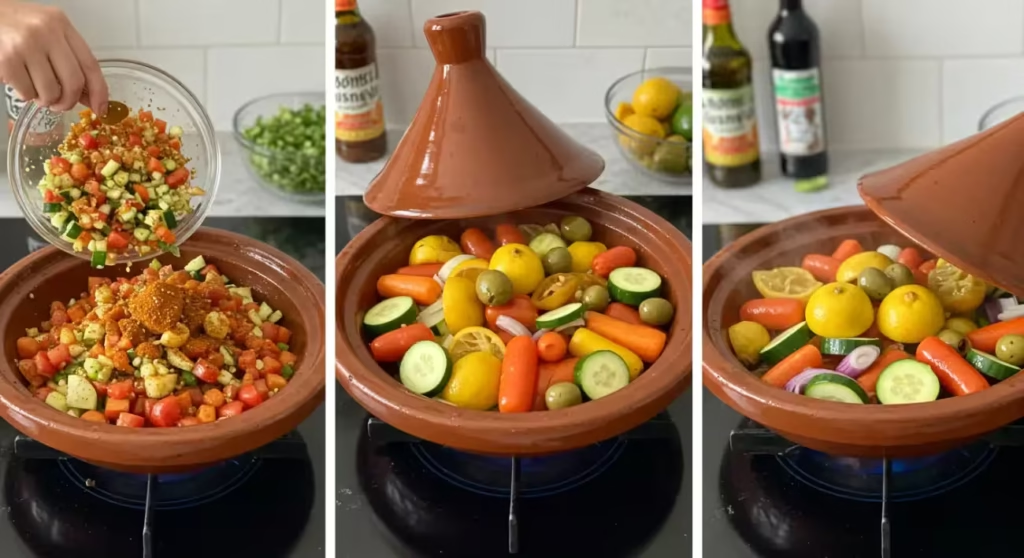
🔪 Step 1: Preparing the Vegetables – Chopping, Seasoning, and Marinating
Preparing fresh, high-quality vegetables is the foundation of an excellent tagine. Begin by washing and peeling your vegetables. Choose a variety of textures and flavors: carrots for sweetness, zucchini for tenderness, eggplant for a creamy bite, and bell peppers for a subtle crunch. Chop the vegetables into medium-sized chunks, ensuring they are uniform for even cooking.
Next, season the vegetables with a blend of Moroccan spices. Combine Ras el Hanout, cumin, turmeric, cinnamon, and a pinch of salt in a small bowl. Drizzle the vegetables with olive oil and sprinkle the spice blend evenly. Gently toss the vegetables to coat them thoroughly, ensuring every piece is infused with the bold flavors of Moroccan cuisine.
For an extra boost of flavor, let the vegetables marinate in the spices for at least 30 minutes. This step allows the seasoning to penetrate and enhances the depth of flavor, giving your food tagine a rich, authentic taste.
🧺 Step 2: Layering in the Tagine – How to Layer Ingredients for Even Cooking
Layering is a crucial step when making a tagine vegetable. It ensures each ingredient cooks evenly and absorbs the flavors of the spices. If you’re using a traditional tagine, spread a layer of sliced onions at the base. This creates a natural bed that prevents sticking and adds sweetness to the dish.
Arrange the marinated vegetables in layers on top of the onions. Begin with denser vegetables like carrots and eggplant, which require longer cooking. Follow with softer vegetables such as zucchini and bell peppers. Scatter a few slices of preserved lemon and a handful of green olives throughout the layers to evenly distribute their tangy, briny flavors.
If you include chickpeas, add them towards the centre or top of the tagine. This positioning prevents them from becoming mushy during the slow cooking process. Finally, pour a small amount of water or vegetable stock around the sides of the tagine, being careful not to submerge the ingredients entirely. This liquid will steam the vegetables and form the base of the flavorful gravy.
🔥 Step 3: The Slow Cooking Process – Tips for Using a Tagine or Slow Cooker
Slow cooking is where the magic happens in a tagine vegetable. Whether you’re using a traditional tagine or a slow cooker, the key is to maintain a gentle, steady heat that allows the flavors to meld beautifully.
If using a traditional tagine:
- Place the tagine on a stovetop over low to medium heat, using a heat diffuser to distribute the heat and prevent cracking evenly.
- Cover the tagine with its conical lid to trap steam, which keeps the vegetables tender and moist.
- Let the tagine cook undisturbed for about 2–3 hours. Avoid stirring too frequently, as this can disrupt the layers and texture.
If using a slow cooker:
- Assemble the ingredients using the same layering method as above. Depending on your schedule, adjust the slow cooker to cook on low for 6 to 8 hours or on high for 3 to 4 hours.
- Slow cookers retain more moisture than tagines, so you may need slightly less liquid.
- The result is just as flavorful and tender, with minimal monitoring required.
🕒 Step 4: Cooking Tips – When to Add Chickpeas, Olives, and Preserved Lemons
Timing is everything when adding the finishing touches to your tagine vegetable. Here’s how to get it right:
- Chickpeas: If using canned chickpeas, add them during the last 30 minutes of cooking to prevent them from becoming overly soft. If using dried chickpeas, ensure they’re pre-soaked and cooked before adding them to the tagine.
- Olives: Add olives about halfway through the cooking process. This allows their briny flavor to blend into the dish without overwhelming it.
- Preserved Lemons: To protect their zesty brightness, add preserved lemons during the final hour of cooking. This ensures they maintain their distinct flavor while infusing the gravy with their tangy, aromatic notes.
Once the cooking is complete, check the gravy’s consistency. If it’s too thin, remove the lid and let the tagine simmer uncovered for 10–15 minutes to allow the liquid to reduce.
With these step-by-step instructions, you’ll be well on your way to preparing a tagine vegetable bursting with Moroccan flavors. This dish is as much about the process as the final result, slow cooking, layering ingredients, and using bold seasonings transform simple vegetables into an unforgettable meal.
🔗 And for a broader culinary context, this Serious Eats article on cooking with clay pots offers great insight into how traditional cookware enhances slow-cooked meals.
Next, we’ll explore how to serve and pair your tagine for the ultimate dining experience!
🧆 Serving and Pairing Tagine Vegetable
Serving a Moroccan tagine is a moment of celebration, of togetherness, tradition, and taste. Every detail, from the side dish to the garnish, contributes to an unforgettable dining experience.
In Moroccan culture, a meal is more than just food. It’s a shared experience, often enjoyed with family and friends around a large table. Once your tagine vegetable is cooked to perfection, the next step is serving it in a way that enhances its rich flavors and hearty textures. A food tagine isn’t just a dish, it’s a complete dining experience. From classic accompaniments to creative pairings, how you serve and pair your vegetable tagine can take your meal to the next level.
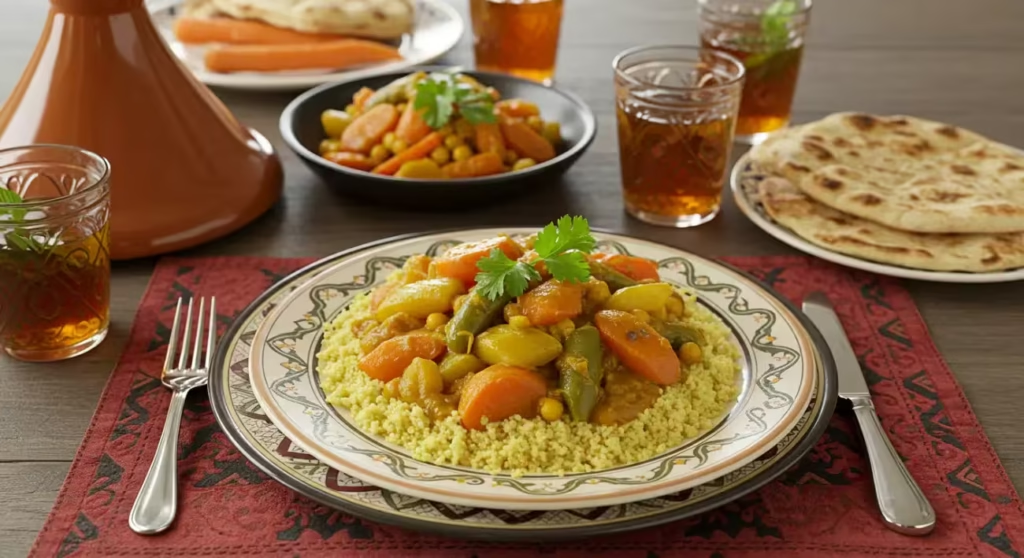
🍛 Classic Pairing: Serving Tagine Vegetable with Couscous
Couscous is the quintessential side dish for tagine vegetable. This tiny semolina pasta is a staple of Moroccan cuisine, and its light, fluffy texture is the perfect canvas for soaking up the rich, flavorful gravy from the tagine, just like in our chicken tagine with apricots and cinnamon, which pairs wonderfully with couscous. To prepare couscous, simply steam it until tender, fluff it with a fork, and drizzle it with olive oil for added richness. For extra flavor, add a pinch of turmeric or cinnamon to the cooking water, which complements the warm spices in the tagine.
Serving the vegetable tagine over couscous allows each bite to deliver a harmonious blend of textures and tastes. This classic pairing highlights the essence of Moroccan cuisine and ensures a filling, balanced meal.
🫓 Alternative Sides: Rice, Flatbread, or Quinoa
If you’re looking for alternatives to couscous, there are plenty of options to suit different preferences and dietary needs:
- Rice: Fragrant basmati or jasmine rice complements the tagine’s robust flavors. Its slightly sticky texture contrasts beautifully with the tender vegetables and gravy.
- Flatbread: Traditional Moroccan khobz (flatbread) or a crusty baguette is perfect for scooping the tagine and soaking up the gravy. This option adds a rustic and interactive element to your meal.
- Quinoa: For a healthy and gluten-free alternative, serve your tagine vegetable with quinoa. Its nutty flavor and fluffy texture make it an excellent base that absorbs spices and gravy like couscous.
Experimenting with these sides allows you to adapt the dish to suit various preferences and occasions, making your food tagine versatile and approachable.
🌿 Garnishing: Fresh Parsley and Coriander for a Burst of Color and Flavor
No tagine vegetable is complete without a sprinkle of fresh herbs. Before serving, generously garnish your tagine with freshly chopped parsley and coriander. These vibrant herbs enhance the dish’s visual appeal and add a refreshing flavor that balances the warm spices. The bright green of the herbs against the rich, golden hues of the tagine creates a feast for the eyes and palate.
If you’re feeling adventurous, top the tagine with toasted almonds, sesame seeds, or a handful of raisins for added texture and sweetness.
🍵 Pairing Ideas: Moroccan Mint Tea, Light Salads, or a Refreshing Yogurt Dip
To round out your tagine vegetable meal, consider adding complementary sides and drinks that enhance the Moroccan dining experience:
- Moroccan Mint Tea: This sweet, fragrant tea made with fresh mint and green tea leaves is the perfect beverage to accompany the bold flavors of the tagine. Served warm, it refreshes the palate and completes the meal in true Moroccan style.
- Light Salads: A simple Moroccan carrot salad with lemon and cumin or a cucumber-tomato salad dressed with olive oil and a squeeze of fresh lemon adds a refreshing contrast to the richness of the tagine.
- Refreshing Yogurt Dip: A cool, creamy yoghurt dip flavored with garlic, lemon, and mint pairs beautifully with the warm spices of the tagine. It adds a cooling element to the meal, especially if you’ve included spicy harissa.
These pairings enhance the flavors of your food tagine and create a well-rounded meal that celebrates Moroccan culinary traditions.
👉 For more ideas on side dishes that pair beautifully with vegetable tagine, this BBC Good Food guide to Moroccan meal accompaniments offers great inspiration.
🎉 The Final Touch
Serving and pairing your tagine vegetable is an opportunity to get creative and make your dish. Whether you stick to traditional couscous and mint tea or explore new options like quinoa and yoghurt dips, the goal is to create a meal that’s as satisfying to eat as it is to share. With its vibrant flavors, beautiful presentation, and endless versatility, a vegetable tagine is more than just a dish, it celebrates Moroccan comfort food. Bon appétit!
🥕 Health Benefits of Tagine Vegetable
In Morocco, eating is not just about taste, it’s a way to care for the body and the soul. The tagine vegetable embodies this balance, blending wellness and tradition in every warm, spiced bite.
For centuries, Moroccan families have embraced vegetable tagines not only for their comforting flavors but also for their nourishing qualities. In Moroccan homes, food is considered both a source of pleasure and well-being.
A tagine vegetable is more than just a flavorful dish, it’s a powerhouse of nutrition. Packed with vibrant vegetables, wholesome legumes, and fragrant spices, this Moroccan-inspired dish offers many health benefits while remaining versatile enough to suit various dietary needs. Let’s explore why this dish is as nourishing as it is delicious.
🌱 Nutritional Benefits of Vegetables and Legumes in Tagine
The base of any tagine vegetable is its colorful assortment of vegetables rich in essential nutrients. Every ingredient contributes its unique benefits to the dish:
- Carrots: Loaded with beta-carotene, carrots support eye health and boost the immune system. Their natural sweetness also balances the spices in the tagine.
- Zucchini: Low in calories but high in antioxidants, zucchini is an excellent source of hydration and vitamins A and C.
- Eggplant: Known for its fibre content and ability to absorb flavors, eggplant contributes to digestive health while providing a creamy texture.
- Tomatoes: A primary ingredient in the gravy, tomatoes are rich in lycopene, an antioxidant that promotes heart health and reduces inflammation.
- Chickpeas: As a legume, chickpeas are a fantastic source of plant-based protein, fibre, and iron. They not only keep you full but also help regulate blood sugar levels.
These ingredients create a nutrient-dense dish of fibre, vitamins, and minerals. Eating a variety of vegetables in a food tagine ensures you’re getting a broad spectrum of nutrients, supporting overall health and well-being.
🍽️ Versatility for Different Dietary Preferences
One of the most appealing aspects of a tagine vegetable is its versatility. This dish can be easily adapted to meet various dietary needs, making it a perfect choice for diverse preferences:
- Vegan and Vegetarian: By focusing on vegetables, legumes, and plant-based fats like olive oil, a tagine vegetable naturally becomes vegan or vegetarian. It’s a wholesome, satisfying option for those looking to reduce their meat consumption or embrace a plant-based lifestyle.
- Gluten-Free: The dish is inherently gluten-free because it doesn’t rely on wheat-based ingredients. Pair it with quinoa or rice instead of couscous for a gluten-free meal.
- Low-Calorie and Heart-Healthy: Absent heavy creams or processed ingredients keep the calorie count low, while heart-healthy spices like turmeric and cumin add anti-inflammatory benefits.
This adaptability ensures that a food tagine can be modified to suit your needs without sacrificing flavor or nutrition, regardless of your dietary goals.
🔥 How Slow Cooking Retains Nutrients and Enhances Flavor
The slow cooking process, a hallmark of tagine preparation, is key to its incredible taste and preserves nutrients. Unlike high-heat methods, which often reduce the nutritional value of vegetables, slow cooking gently preserves their vitamins and brings out deep, satisfying flavors.
- Retaining Nutrients: High-heat cooking methods often lose water-soluble vitamins like vitamin C. Slow cooking, on the other hand, keeps the temperature low and uses minimal liquid, preserving these vital nutrients.
- Enhancing Flavor: The extended cooking time allows the spices to fully penetrate the vegetables, creating a rich and aromatic depth of flavor. This gradual melding of ingredients ensures that every bite is packed with taste and nutrition.
- Digestive Ease: Slow cooking also helps break down the fibres in vegetables and legumes, making them easier to digest and more bioavailable for nutrient absorption.
Using a traditional tagine or a slow cooker, you’re not just cooking, you’re creating a dish that maximizes flavor and health benefits.
👉 Learn how slow cooking can preserve the nutrients in vegetables by checking out this Harvard Health guide to cooking methods, an authoritative source on healthy meal prep.
❤️ A Dish That Nourishes the Body and Soul
A tagine vegetable is the perfect example of a dish that satisfies on every level. Its abundance of fresh vegetables and legumes supports a healthy diet, while its adaptability makes it suitable for various lifestyles. Slow cooking enhances the dish’s flavors and ensures you get the most out of its nutritional potential. Whether you’re looking for a hearty meal, a plant-based option, or a comforting dish to enjoy with your family, this Moroccan food tagine is a delicious way to nurture your body and soul.
🔗 Do you enjoy healthy vegetarian recipes? Try our Moroccan Zucchini Salad – A Low-Calorie Fit Food, perfect as a side dish or a light meal.
🌿 Conclusion: Bringing Moroccan Comfort to Your Table
A tagine vegetable combines simplicity, nourishment, and heartwarming flavors perfectly. With its vibrant mix of fresh vegetables, wholesome legumes, and aromatic spices, this dish transforms everyday ingredients into a feast of comforting delight. Whether you’re a seasoned cook or trying Moroccan cuisine for the first time, the ease of preparation and the versatility of a food tagine make it a must-try recipe for any occasion.
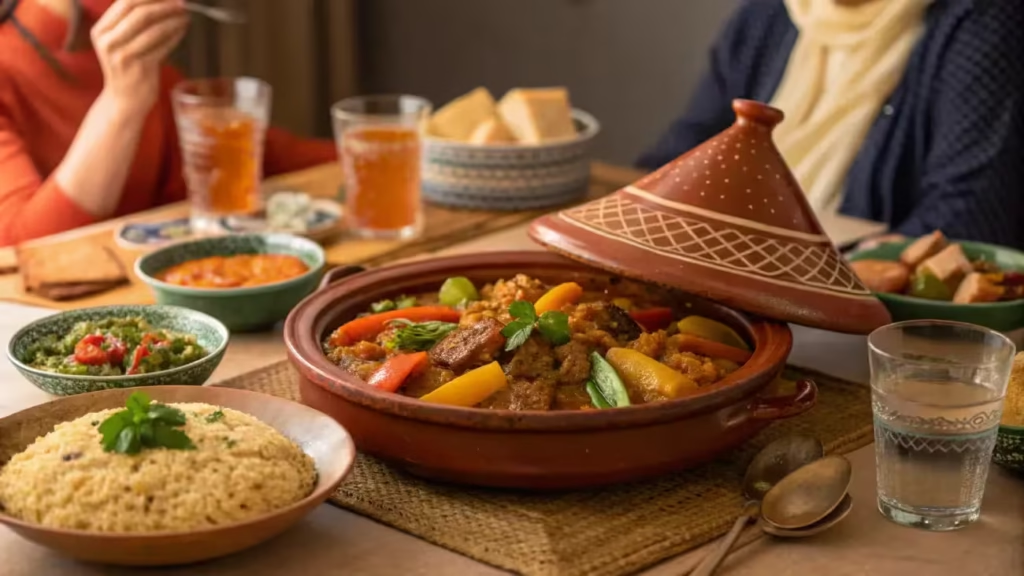
What makes a vegetable tagine truly special is its ability to bring people together around the table. Its warm, inviting aroma, rich textures, and bold flavors offer a sensory experience as satisfying as the meal. The beauty of this dish lies not just in its taste but in its flexibility. Whether you serve it with traditional couscous, experiment with a modern side like quinoa, or adapt the ingredients to suit dietary preferences, a tagine vegetable offers endless possibilities.
Now, it’s your turn to bring the magic of Moroccan cuisine to your kitchen. This recipe is more than just a meal, an invitation to explore new flavors, try different combinations, and make it your own. Don’t hesitate to customize it based on the vegetables you love, or add a protein like chickpeas or meat for a heartier option. Each time you prepare it, you’ll find new ways to make it uniquely yours.
We’d love to hear about your experiences! Have you tried this food tagine recipe?
What variations did you add to make it your own?
Share your thoughts, tips, and even photos in the comments below. Your feedback helps inspire others and keeps the tradition of sharing recipes alive.
Finally, if you enjoyed this tagine vegetable guide, share it with your friends and family. Whether a cosy dinner at home or a festive gathering, this dish is the perfect way to introduce others to Moroccan cuisine’s comforting and flavorful world.
Bon appétit! 😊
❓ Frequently Asked Questions (FAQs)
Here are answers to some common questions about making and serving tagine vegetable to help you master this comforting Moroccan dish.
1. Can I make tagine vegetable without a traditional tagine pot?
Absolutely! While a traditional tagine pot is ideal for making authentic Moroccan food tagine, you can use a slow cooker, Dutch oven, or heavy-bottomed pot as a substitute. These alternatives still allow for slow cooking and ensure the vegetables absorb all the rich flavors of the spices.
2. What vegetables work best in a tagine vegetable?
A variety of vegetables can be used to create a flavorful tagine. Common choices include carrots, zucchini, eggplant, bell peppers, and tomatoes. You can also add seasonal vegetables like sweet potatoes, green beans, or squash to customise the dish.
3. Can I make a vegan or gluten-free version of tagine vegetable?
If you use plant-based ingredients, a tagine vegetable is naturally vegan. It’s also gluten-free when served with rice or quinoa instead of couscous. For added variety and a protein boost, try incorporating chickpeas or lentils.
4. How do I store and reheat leftover tagine vegetable?
Store any leftovers in a sealed container in the fridge for up to three days to maintain freshness. To reheat, place the tagine in a pot over low heat, adding a splash of water or stock to refresh the gravy. For a faster option, microwave the dish briefly until warmed through.
5. Can I make the dish spicy?
If you prefer a spicy kick, add a spoonful of harissa paste or a pinch of chili flakes to the spice blend. Adjust the amount based on your spice tolerance to keep the dish balanced and enjoyable.
6. What can I serve with tagine vegetable?
Couscous is the classic pairing, but you can also serve it with rice, quinoa, or warm flatbread for variety. Add a side of Moroccan carrot salad or a refreshing yoghurt dip to complete the meal.
7. Can I freeze tagine vegetable?
Yes, the tagine vegetable freezes well. Let the dish cool thoroughly before placing it in a freezer-safe container. You can freeze it for up to three months and thaw it in the refrigerator overnight before reheating.
If you have more questions about making or serving tagine vegetable, feel free to ask in the comments. Cooking is all about experimenting and sharing, and we’re here to help you enjoy every step of the journey! 😊
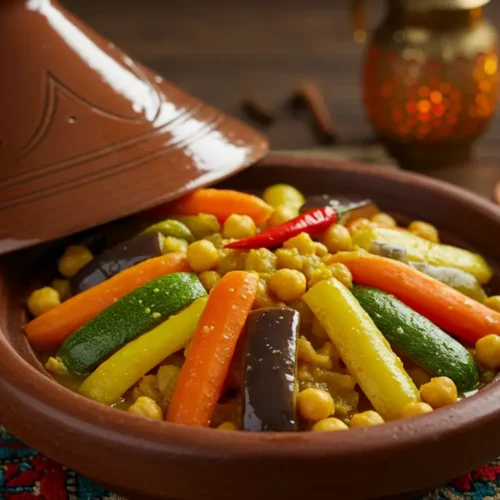
How to Make the Perfect Tagine Vegetable: A Comforting Delight
Equipment
- 1 Tagine
Ingredients
Vegetables
- 2 medium carrots peeled and sliced
- 1 zucchini sliced
- 1 eggplant cubed
- 1 bell pepper red or yellow, chopped
- 2 medium tomatoes chopped
Legumes
- 1 1 cup cooked chickpeas (or canned, rinsed and drained)
Aromatics:
- 1 large onion sliced
- 3 garlic cloves minced
Spices:
- 1 tsp Ras el Hanout
- 1 tsp ground cumin
- 1 tsp turmeric
- ½ tsp cinnamon
- ½ tsp paprika
- ½ tsp black pepper
- 1 tsp salt or to taste
Additional Ingredients:
- 1 preserved lemon quartered
- ½ cup green olives pitted
- 1 cup vegetable broth or water
- 2 tbsp olive oil
For Garnish:
- Fresh parsley chopped
- Fresh cilantro chopped
Instructions
Prepare the Vegetables:
- Wash, peel, and chop all vegetables into medium-sized pieces for even cooking.
- Toss the vegetables with Ras el Hanout, cumin, turmeric, cinnamon, paprika, black pepper, and olive oil. Let them marinate for 15–30 minutes to enhance flavor.
Layer in the Tagine or Slow Cooker:
- If using a traditional tagine, place sliced onions at the base to prevent sticking.
- Layer the marinated vegetables on top, starting with carrots and eggplant (denser vegetables) and finishing with zucchini and bell peppers.
- Scatter the chickpeas, preserved lemons, and olives throughout the layers.
Add Liquid and Cook:
- Pour the vegetable broth around the edges of the tagine or into the slow cooker.
- Cover and cook:
- In a tagine: Simmer on low heat for 2 hours.
- In a slow cooker: Cook on low heat for 6 hours or high heat for 3–4 hours.
Finish and Serve:
- Garnish with fresh parsley and cilantro before serving.
- Serve over couscous, rice, or with flatbread for a complete Moroccan-inspired meal.
Notes
- Substitute preserved lemons with fresh lemon slices and a pinch of salt if unavailable.
- Add a spoonful of harissa paste for extra spice.
- Leftovers can be stored in an airtight container for up to 3 days or frozen for up to 3 months.
Nutrition Information (per serving):
| Nutrient | Amount |
|---|---|
| Calories | 280 |
| Protein | 8g |
| Carbohydrates | 35g |
| Fat | 12g |
| Fiber | 10g |
| Sodium | 820mg |
Stay connected and join me on social media for more delicious recipes, cooking tips, and inspiration! Follow along for updates, behind-the-scenes content, and mouthwatering food ideas. Let’s share the joy of cooking together!
Get notified when we post new tasty recipes!
📩 Join Our Moroccan Foodie Community
Get the best Moroccan tagine recipes and seasonal culinary tips straight to your inbox.
🏠 Discover More Moroccan Recipes!
🥘 Craving more delicious Moroccan dishes? Head over to our All recipes page for a collection of authentic recipes, cooking inspiration, and flavor-packed meals! Explore now! 🚀🍽️
Clarifying Essential Terms and Ingredients
To help you better understand the ingredients and elements mentioned in this article, here are brief explanations of key terms commonly used in Moroccan cuisine:
Khobz
This traditional Moroccan bread is a round, flat loaf with a dense yet soft texture. Used to scoop up tagines, stews, and dips, khobz is a staple in every Moroccan household. Made with simple ingredients like flour, water, salt, and yeast, it embodies the communal and cultural traditions of Morocco.
Ras el Hanout
A hallmark of Moroccan spice blends, “Ras el Hanout” translates to “head of the shop,” representing the finest spices a merchant can offer. This versatile blend typically includes a mix of warming spices such as cinnamon, cumin, turmeric, and ginger, and is used to flavor iconic dishes like tagines and couscous.
Saffron
Revered as “the golden spice,” saffron is obtained from the fine, hand-harvested threads of the crocus flower, making it a rare and precious addition to any dish. It imparts a rich yellow color and a subtle, earthy aroma to Moroccan dishes, from tagines to desserts. Its labor-intensive harvesting process makes it one of the most valuable spices in the world.
💬 What did you think of this Moroccan vegetable tagine?
Feel free to share your experience, variations, or questions in the comments below. We love hearing from fellow food lovers! 🍽️❤️
